 |
| The lighthouse bends as the distant building looms overhead, like a scene from Inception |
In this post, we discuss fisheyes in general and we review the Tokina 10-17 fisheye lens. First, I'll show comparisons between rectilinear ultrawide images and fisheye images. Second, we'll talk about fisheyes. Third, I'll provide some samples of how fisheyes can be used (aside from 'funny' shots). Finally, I'll discuss the Tokina 10-17.
I. FISHEYE VS. RECTILINEAR COMPARISONS
If you like your rectilinear ultrawide, you know how its extreme perspective can make your other lenses look boring. Well, a fisheye's crazy distortion can make your rectilinear UWA look like just another boring lens. Here are some comparisons: |
| With a UWA, it's like a party going on... |
 |
| With a fisheye, the other buildings are getting up to join the party |
 |
| Your "wild" rectilinear makes the building look like it's tipping over... |
 |
...while a fisheye makes that building look like it's about to eat that other building
|
 |
| A UWA invites you to explore the topsy-turvy architecture... |
 |
| ...while a fisheye invites you to defy gravity |
 |
| With a UWA, the flowers look ready to start a Broadway song-and-dance number |
 |
| With a fisheye, they look ready to start a protest rally |
II. ABOUT FISHEYES
A. Distortion
We know there are two major types of ultrawide lenses: rectilinear (aka rectangular) and fisheye. With rectilinear ultrawides, straight lines look straight, in every direction. However, objects outside the middle of the frame will seem stretched toward the edge of the frame. Here's a sample:
 |
| Rectilinear UWA sample - The car appears to stretch toward the edge of the frame |
A fisheye lens looks like it has very strong barrel distortion, with the middle of the frame appearing to bulge out, and straight lines will look curved unless they pass through the exact middle of the frame. Although objects will appear curved, they won't appear too stretched.
 |
| Fisheye lens - straight lines are curved but the car has more-or-less normal proportions |
In most fisheyes, objects that are closer to the edge of the frame and that are closer will appear more curved than objects near the middle of the frame and are farther (in a few fisheyes such as the Samyang 8mm, the amount distortion is even across the frame).
 |
| Compare the far column near the middle of the shot, which has no distortion, versus the column on the left side of the shot |
The maximum field of view of a rectilinear lens is about 120 degrees. On the other hand, a fisheye lens field of view is typically 180 degrees measured diagonally (Nikon made a 6mm fisheye with a field of view of 220 degrees, allowing it to see "behind" itself).
C. Circular vs. Full-Frame Fisheye
There are two kinds of fisheye lenses. One kind of fisheye lens will produce a circular image. This kind of fisheye lens will have the same field of view in all directions (vertically, horizontally, diagonally). Outside of the image, it will appear black. The other kind of fisheye lens, so-called a full-frame fisheye (aka rectangular fisheye), fills the entire frame with the image. With this latter kind of fisheye, the diagonal field of view may be 180 degrees, but the horizontal and vertical fields of view will be less. In between the two main types of fisheyes, there are also some fisheyes that produce a partial circle.
D. Focal Length
There are many lenses that are described as fisheyes with different focal lengths, but they all have the same 180-degree field of view. So what's the difference between the Samyang 8mm fisheye and the Nikon 10.5mm fisheye for example?
First, some fisheye lenses may offer a more complete circle than others. For example, the Sigma 8mm is a true circular fisheye lens and has a 180-degree field of view at all angles, whereas the Nikon 10.5mm is 180 degrees only when measured diagonally (unless used on a full frame camera as a partial circular fisheye lens, in which case it is also 180 degrees horizontally, but not vertically). That difference in actual coverage can account for the different focal length.
Second, given the same or similar field of view, fisheye lenses with a shorter focal length have less distortion. See comparisons between the Sigma 8mm, Samyang 8mm, Tokina 10-17 and Nikon 10.5 (press the cursor keys left or right to advance the slideshow). Credit: Michel Thoby.
http://michel.thoby.free.fr/SAMYANG/1110andCo.swf
http://michel.thoby.free.fr/SAMYANG/1111andCo.swf
E. Rotation and Tilting
Fisheyes are very sensitive to rotation and tilting. Tilting the camera can produce very different images. In the example below, the same building can look very different, merely because of a change in camera angle and slight change in camera position.
F. Exaggerated Distances
As with rectilinear ultrawides, a fisheye can make distances appear exaggerated. Close objects appear even closer. Far objects appear even farther. One practical consequence of this characteristic is that you have a lot of control over the foreground. In the shots below, the buildings look almost identical but the foreground appears very different. All I did was to take a few steps closer to the flowers.
Note: the shots above were de-fished in Lightroom 4.1.
III. WHAT ARE SOME USES FOR A FISHEYE?
Everyone has seen fisheye portraits with exaggerated facial features for humor. I'm not into that. I'm interested in uses for a fisheye that are striking and aesthetically pleasing. Here are some of them:
1. Curves.
When the scene is dominated by curves and circles, I find that using a fisheye often complements the scene and a nonphotographer might not even know it was taken with a fisheye.
 |
| Caesar's Palace lobby |
A similar example is a scene with zero-point perspective (a scene where there are no parallel lines), such as underwater scenes and nature scenes. Without parallel lines, the use of a fisheye is not at all obvious, much less intrusive. Here are some examples that I like:
Masahiro Miyasaka's landscapes, such as this (taken with a Sigma 15mm fisheye):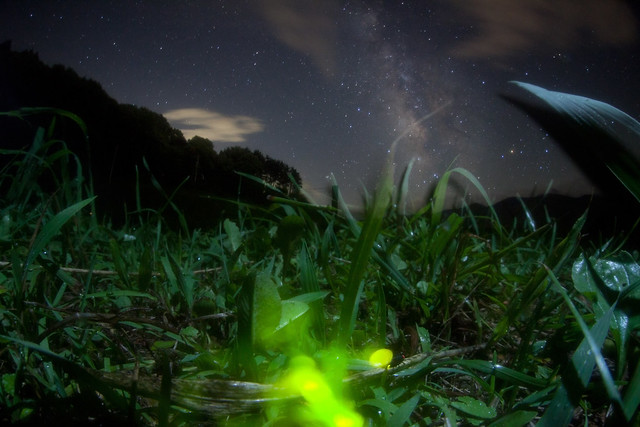
2. Fun
In places where we are expected to suspend our disbelief, a fisheye visually conveys the sense of fantasy.
 |
| Chocolate fountain at Bellagio |
 |
| Bellagio conservatory |
3. Impossibly wide rectilinear. A fisheye can be de-fished partially or completely (with Lightroom, PTLens, ImageAlign or other sofware) to provide a rectilinear view that is wider than many rectilinear lenses, even ultrawides.
 |
| original uncorrected fisheye image |
 |
| same shot, with correction in Lightroom |
Believe it or not, people can look more "normal" with a fisheye lens than with a rectilinear UWA. With a rectilinear lens, people outside the middle of the frame will be stretched toward the edges. With a fisheye lens, people aren't stretched, and their faces look more "normal" across a larger portion of the frame. Example:
 |
| Tokina 11-16 @ 11mm. The people at the middle look normal, but people at the edges look stretched wider |
 |
| Tokina 10-17 Fisheye @10mm. Lines are curved but faces look more normal across a larger portion of the frame |
5. Impossible views
A fisheye captures an extremely wide field of view. Normally, the objects within that field of view would not be visible within the same frame using a more typical lens unless the lens is distant. In some cases, those distances are impossible, therefore a fisheye can provide views that seem impossible and thus unusual and more memorable. For example, you can take a shot from inside small spaces (ovens, refrigerators, washing machines, mailboxes).
Example by Keep the Funk Alive
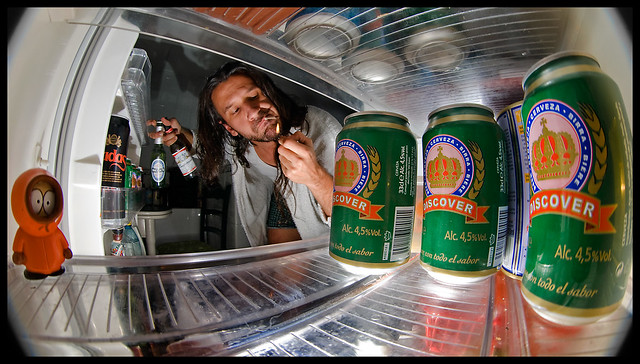
6. Seeing opposite sides
Because of the extremely wide field of view of a fisheye lens, it is often possible to have subjects that are almost 180 degrees apart appear in the same frame. This can be useful for practical purposes or dramatic shots. For example, with a fisheye we can capture both an object and the facial expression of the subjects looking at the object.
 |
| Watch out - this giant Tinker Toy squirts water! |
7. Abstract photography
A fisheye can be a useful tool for making an object look much less recognizable and instead presented purely as shapes, lines and/or colors.
8. Architecture
"Mic, you've got to be kidding, right? People spend good money on lenses that avoid distortion when taking architecture photos." That's true of course. But when a lens represents reality too closely, I feel like I'm merely echoing what the architect has done. In my opinion such a photo has little intrinsic artistic value. A fisheye OTOH allows a photographer reimagine a structure to make an artistic statement that is distinct from (though partially dependent upon) the architect's.
 |
| With a fisheye, this unassuming parking structure becomes a tribute to Norman Foster |
The wide field of view of a fisheye lens facilitates the capture of 360-degree panoramas. These in turn can be converted into stereographic projections.
"Octopussy planet," an example of a little planet stereographic projection by Klaus Friese
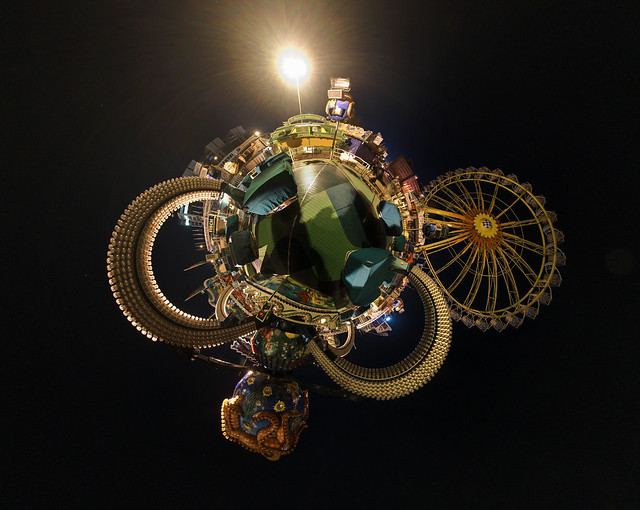
"Cais Giddiness," a spectacular stereographic projection by Omar Junior (Pentax fisheye)

IV. TOKINA AT-X 107 DX (10-17 Fisheye)
The Tokina 10-17 is a full-frame (not circular) fisheye lens for crop-sensor bodies. It is very similar to the Pentax 10-17 (they are optically identical though mechanically different). Physically, it is quite small and compact. Its body is plastic but it feels very solidly built.
The Tokina 10-17 is one of the few fisheye lenses that are zoomable. I don't use the zoom much and I almost always use it at 10mm. However, the zoom is useful for allowing the 10-17 to be used on a full frame body (see below). I may also try a zoom blur type of shot in the future.
The 10-17 is very sharp when stopped down:
 |
| f/8 |
Speaking of focus, note that the Nikon version of the Tokina 10-17 has no built-in autofocus motor. It will not autofocus on bodies that don't have a focus motor, although you will have focus confirmation, and focusing manually will be a little easier because of the deep depth of field.
One issue that may be of concern to some users is purple fringing. The Tokina is vulnerable to it. Fortunately, it can be easily corrected using Lightroom 4's Defringe tool.
De-Fishing the 10-17
Images from the 10-17 can be de-fished to produce a rectilinear image that is wider than some true rectilinear ultrawide lenses. Fortunately, Lightroom 4.1 includes a lens correction profile for the Tokina 10-17, making it easy to de-fish images, albeit only partially.
Here is a shot at 10mm:
I de-fished the shot above in Lightroom 4.1 by applying the Tokina 10-17 lens correction profile and increasing the correction for distortion to 200%. Here's the result:
There's still a lot of distortion left, plus the defished corners are blurred. However, the shot is wider than my Tokina 11-16 at 11mm. Here's the 11mm for comparison (you can count the number of bricks to compare the width):
Performance on Full Frame Cameras
Although the Tokina 10-17 is designed for crop-sensor cameras, it can also be used in full-frame bodies (not sure about the Canon version -- the mirror may hit the lens). At 10mm, the lens hood blocks part of the image:
Some users have sawed off their lens hood because of this so that the 10-17 can be used as a partial circular fisheye. In fact, Tokina also produces a version of this lens (designated "NH") that does not have a hood.
Even with the hood, however, the lens can be used without vignetting when zoomed to around 14.5mm.
As you can see it provides an even wider field of view compared to 10mm on a crop-sensor body. As with the crop-sensor image, the full-frame image can be partially de-fished in Lightroom.
After correction, the image is still wider than the Tokina 11-16 at 16mm (full-frame):
 |
| Tokina 11-16 used on full-frame body at 16mm |
V. ALSO CONSIDER: ROKINON/SAMYANG
Another fisheye lens I was considering is the Samyang 8mm, which is also sold under other brands such as Rokinon, Pro-Optic and Bower. Besides price, one of the advantages of this lens is that it has more even distortion than other fisheyes. In fact, it is used for scientific purposes because of that unique characteristic.
The older Samyang has no autofocus, no exposure information, and was basically a totally manual lens. The newer version of this lens has a chip that allows autofocus confirmation.
VI. MORE FISHEYE SAMPLES
Even more samples:
http://flickriver.com/search/fisheye/interesting/ - but note: if image has straight lines, it might not be fisheye
"Time Flies" by one of my favorite pros, Ryan Brenizer
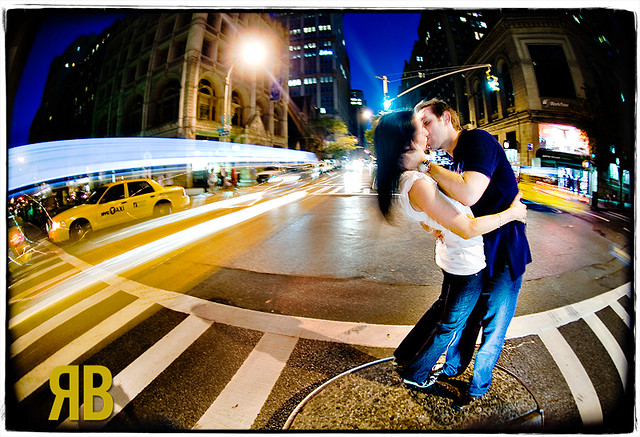
The famous stairs of the Galerie Vivienne by Vincent Montibus

Lastly, you absolutely should check out the amazing and often funny (though sometimes macabre) images of Scott MacBride (possessed2fisheye)





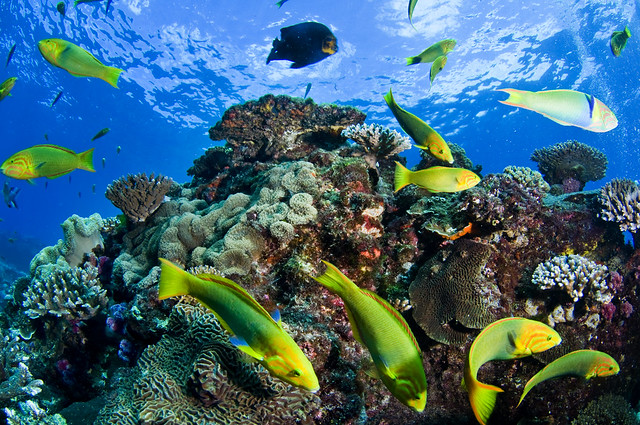


















Wow, nice article,almost what i was looking for , thx for this !! :-)
ReplyDeleteStill, what i really am looking for but till now haven't found : Shots of the same subject on a DX camera ( so non shaved lens) from the same point of view with the different FE lense, so that they become realy comparable..
I know its a lot to ask for, but it would also be the best way to enable choosing a FE lens for my (DX) camera.
Again Thx a lot for this interesting write up which now helps me one step further with finding the right lens for me !!
Warm Regards,
Chris.
Thanks for the feedback Chris!
DeleteAs for the comparison you're looking for, I haven't seen such a comparison either. Unfortunately I don't have access to any other fisheye lens (I'm just an amateur, so all the equipment reviewed here are bought by myself, not provided by companies for review). My suggestion is to look at Michel Thoby's slideshow and just crop it to DX. Or possibly ask Michel for the DX comparison.
Best regards,
Mic